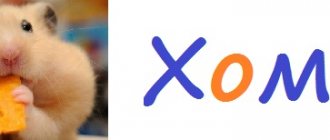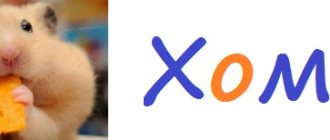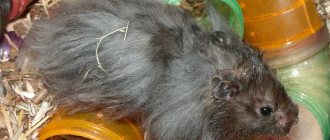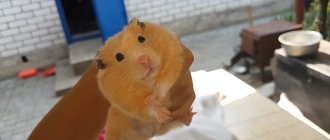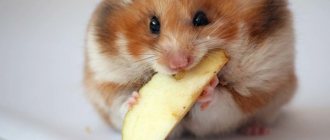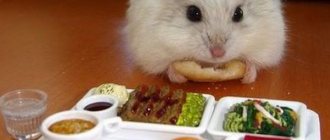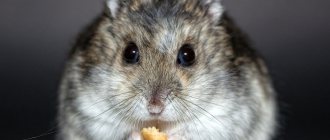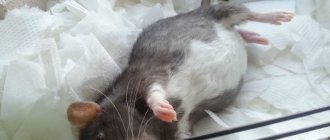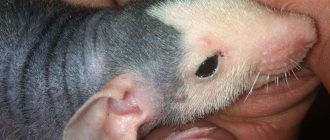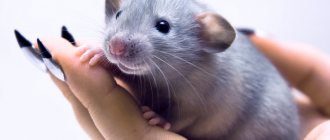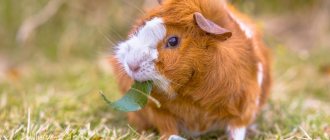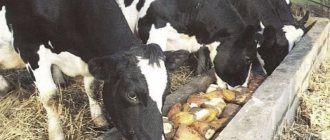Are you planning to get a dzhungarika? It would be wise to familiarize yourself with the rules for keeping the animal in advance and understand how to care for it.
Already have a hamster and have doubts about how to properly care for it? Read the article to the end, and you will have virtually no questions left about the care, maintenance and nutrition of the Djungarian hamster at home.
Proper care means a happy hamster!
Choosing a house for a dzhungarik
It is most convenient to keep and care for a Djungarian hamster in:
- cage
- dune
- large aquarium (with good ventilation)
- terrarium
- rack
Let's look at each option in a little more detail.
Cell
A cage is one of the most convenient homes for keeping a hamster. Most importantly, when purchasing, pay attention to the following points:
- The pallet is preferably plastic. Wooden is chewed, and it absorbs odors.
- For ease of maintenance, it is better to take it with a removable tray.
- Choose higher plastic sides: less filler will fly out of the cage.
- The rods must be metal (again, so as not to be chewed).
- Choose a cage with small distances between the bars. Djungarians are so small that they crawl between them, and it is impossible to keep them in such a house.
- The recommended bottom size for one animal is approximately 30x50 cm.
- Inspect the entire structure: there should be no burrs, sharp edges or protruding ends of the wire anywhere. The baby is easy to hurt.
Dune
Dunes for keeping rodents are becoming increasingly popular. And for good reason. The advantages of such houses:
- the sides are solid: no matter what games the Djungarians play, there will be no filler on the floor;
- even the smartest hamster will not be able to open the door in the “ceiling”;
- the upper part is transparent, you can clearly see what the animals are doing;
- small dunes can be used as portages;
- very easy to clean thanks to its simple and well-thought-out design.
There are also mixed options for keeping, which can be called “cage dunes”. Typically in these dunes, more sections of metal cage are inserted between the tray and the lid. This way you can increase the height and provide ventilation.
You can buy ready-made houses of any variety here (there are both budget options and luxury “villas” for keeping a pet).
Dune, cell and their hybrid.
Aquarium
Keeping hamsters in an aquarium is not recommended. The fact is that they are usually narrow and poorly ventilated. In addition, if the aquarium is glued together and not solid, poisoning from the glue is possible (rodents taste everything).
The advantage of keeping it in an aquarium is that you can clearly see how your pet plays. Children especially appreciate this. If you buy an aquarium that does not contain harmful substances and provide a flow of fresh air (forced ventilation), then there will be no harm to your Djungarian pet.
Terrariums and glass shelving
This is a good option for keeping (subject to a minimum bottom size of 30x50 cm). Everything is visible, very spacious and (in the case of shelving) takes up little space. The only drawback is that care is not very convenient. An excellent choice for breeding Djungarian hamsters, but for one individual there is probably no point in such a large house.
Houses made from scrap materials
Based on the size requirements (30x50 for one rodent) and ventilation, tiny options such as a jar or cardboard box are immediately eliminated: high-quality care and maintenance of a Djungarian hamster in them is impossible. Otherwise, complete freedom for your ideas. The main thing is to ensure sufficient size and air flow.
Not that I'm complaining, but isn't there something bigger?
Cost of Djungarian hamsters
When buying a Djungarian hamster, it is advisable to pay attention to factors such as:
- Pet's age. The hamster should be about 5-6 weeks old.
- Character of behavior. The animal should not be too apathetic and lethargic, or overly excited or nervous.
- Health. His state of health visually should not raise the slightest doubt.
- Wool cover. It should be dry and clean, without signs of bald spots or mechanical damage.
- The condition of the eyes, which should be clean, without traces of various discharges.
- The condition of the nasal cavity, which also should not have traces of various secretions.
- The condition of the fur around the anus should be characterized as clean and dry.
If a person has little experience, then it is quite difficult to distinguish the sex of very young individuals. This is true even for breeders. It is better to know for yourself how to distinguish a male from a female. Similar animals can be bought for 250-350 rubles, regardless of gender. If hamsters have a rather rare color, then the cost of such individuals is slightly higher.
What does a hamster need in a cage?
List of what you need to keep a Djungarian hamster:
- small house for sleeping and storing supplies
- running wheel and/or labyrinth (required)
- food utensils
- drinking bowl
- mineral stone
- twigs for grinding teeth
- filler
Do not rush to “fix” all the objects in the cage according to your own design. First, let the dzhungarik determine a place for the toilet. And only then place food, water and a mini-mink as far away from it as possible.
Gym for dungarians
The running wheel is not intended for family observation of the hamster running in it, it is necessary for the health of the hamster. In nature, a hamster runs up to 12 km per night in search of a “snack.” When kept at home, there are 20 centimeters before eating, so the Djungarian hamster will quickly begin to gain fat. Given the tendency of this type of hamster to develop diabetes, obesity will end very badly. The rodent needs to engage in “sports”.
In addition to the wheel, a labyrinth of pipes “works great” - a small Djungarian hamster runs through them no less willingly than in a wheel. Interesting options for maintaining physical fitness can be found in the sections of the store with accessories and toys.
Excellent “apartment” with everything you need. And the area is okay...
Filler
We advise you not to use scrap materials as bedding in the house. Fibrous materials (for example, cotton wool) are strictly prohibited - the dwarf is tiny, it can get entangled in them. The preferred option for “homemade” fillers is finely chopped paper and napkins. The main thing is to make sure that it is without flavorings and printing ink. Paper with sharp edges (like office paper) is also unacceptable.
The best choice for caring for the dwarf is ready-made granular fillers, an abundance of which can be found in this pet store. As an alternative, you can use self-harvested sawdust (but not in the form of fine dust - it gets into the respiratory tract).
That's it. Owner, respect!
Teeth sharpener and mineral stone
The Djungarian hamster's teeth grow constantly (like your nails), so care is indispensable without a “sharpener.” These can be small branches of trees or bushes. You can prepare it yourself (an excellent option is an apple tree) or buy ready-made ones in the store. If you don’t foresee how the hamster will wear down his teeth, he will start gnawing everything around, starting with his home.
The hamster also needs a mineral stone to replenish microelements in the body.
Maintenance and nutrition
Pet cage
| Cell | Price |
| Ferplast Hamster Duo rodent cage | RUB 3,800 |
| Criceti 9 Princess 9 for hamsters 46×29.5×23 cm | RUR 1,851 |
| Ferplast Ferplast Olimpia 46×29.5×54 cm | RUR 4,355 |
| TRIOL Triol YD415 340x280x250 mm | RUB 1,137 |
| TRIOL Triol 1403 580x320x320 mm | RUB 2,314 |
Despite the modest size of the animal, the cage should be relatively large. The minimum dimensions are 55x30 cm. In some cases, in order to avoid unnecessary injuries, a single-tier cage is recommended. Instead of the usual version of rods, you should pay attention to cage options with plastic inserts and closed dunes.
At home, unfortunately, Djungarians can only survive in a cage because they are very picky about food and external conditions, this is not a Roborovsky hamster, which can also fight back!
The presence of pipes and various tunnels, labyrinths and passages will help the animal quickly feel the homely atmosphere. Indeed, in nature, hamsters constantly dig labyrinths and tunnels for themselves: this is important for them in terms of life and personal safety.
The cage should be in a quiet place, protected from drafts and direct sunlight. A house in a cage must be provided for the animal’s privacy. For the Dzungarian species, the optimal size of the house is 10 cm. You can purchase the simplest design without windows and bottom.
A thick layer of filler is poured onto the bottom of the cage: the thicker it is, the better for the rodent. You should choose cellulose or corn options. Rags, napkins or paper towels will help your hamster build his nest. It is important that the fabric is white, without dyes.
The main equipment for the cage are the following household items:
- A house where he can easily escape if he needs privacy.
- Lazy. They can be of various shapes and heights so that the rodent does not get bored.
- A specialized toilet designed for small rodents.
- Bedding made of compressed sawdust.
- A drinking bowl with a volume of at least 50 ml. It is best to purchase an automatic water supply option.
- Place of animal hygiene in which sand must be poured. It must be dry and clean.
An alternative to a standard cage, in the case of Djungarian hamsters, can be an aquarium. Narrow containers for keeping rodents are not suitable due to poor ventilation, so you need to choose the standard rectangular option. Otherwise, bacteria that are harmful to the animal may multiply in the aquarium.
Pet sports area
To maintain an optimal level of health, the animal needs to cover a distance of 10 km per day. You can help your animal maintain this activity using a running wheel. The diameter for a dwarf rodent should not be less than 16 cm. There should be no crossbars, and the distance between the rods should be such that the pet’s paws do not fall into it when running.
In addition to the wheel, a number of owners purchase balls for walking. With its help, your pet can calmly walk around the apartment without touching wires or chewing furniture. Additional devices can include labyrinths, tunnels and obstacle courses.
Eating area
The best option for a rodent feeder would be a deep metal container. It will not roll over and is easy to clean. In the case of a closed feeder, it is hung on the walls or bars of the cage.
Additional accessories
Sometimes a carrier cage may be needed. The hamster can also be placed in it when cleaning the cage.
It is better to feed animals in the evening, when they begin to become active. The drinking bowl in the cage needs to be changed regularly. Spot cleaning should be done daily. This procedure includes changing the filler, as well as yesterday’s food with fresh food.
Hamsters themselves organize a toilet using fresh litter; they are quite clean.
Despite the need to maintain cleanliness, spring cleaning is stressful for a hamster. Therefore, washing the cage should not be done more than once a week. Washing should be done with a clean sponge and fragrance-free soap. It is important to treat all accessories during cleaning and then wipe dry. The drinking bowl also needs to be disassembled and washed thoroughly.
Cage cleaning should be carried out according to schedule. Even if the cage is heavily contaminated, chemicals should be avoided. In order to remove stains from waste residues, you can use vinegar, applying it to the epicenter of contamination for 15-20 minutes, then remove it with a damp cloth.
Hamsters are very sensitive animals. Especially their psyche can be shaken by general cleaning of the food reserves that they are actively creating. Cleaning too often can lead to stress for the animal. Therefore, you can reduce the risk of psychological trauma by removing only spoiled varieties of food.
Communication process
Djungarian hamsters are independent and rarely make contact with their owner on their own. Some individuals may begin to bite the owner while attempting contact. You need to accustom your animal to handling gradually, with less stress for both parties. Don't expect too quick results. If there is no progress, you need to contact a veterinarian; perhaps, communication with a person is physically unpleasant due to the animal’s hidden ailments.
It is also worth remembering that if there is no contact with the pet for 1-2 weeks, it will go wild again and you will have to start the procedure again.
The hamster is a nocturnal animal, so during the daytime it is lethargic and passive. But in the early evening you can accustom the animal to communication. Some individuals are given basic training. In order for the owner to sleep comfortably at night, you can use earplugs, or slightly adapt your regime to suit your pet.
Where is the best place to keep it?
The Djungarian hamster must be kept in a spacious cage: the animal is quite mobile and needs a lot of space to play. If the cage is too cramped, the hamster will be in a constant state of stress, which will lead to illness and early death.
The cage for Djungarian hamsters must meet the following requirements:
- the cage bars should not be galvanized; its dimensions should be at least 30 by 50 centimeters. If there is no cage, the hamster can be kept in a spacious aquarium. The aquarium must have low walls, otherwise, due to poor air ventilation and dampness, colonies of bacteria and fungi will appear in it, which will affect the health of the hamster;
- sand or small sawdust are suitable as bedding. Cotton wool, newspapers and scraps of fabric should not be placed on the floor of the cage: they can harm the health of the animal. Particles of thread and cotton can get into the respiratory tract and cause irritation, and newspapers are printed using toxic inks;
- the cage should contain branches, large roots and other objects that the Djungarian hamster can climb;
- in nature, Djungarian hamsters live in burrows, so the animal must have a house that can be attached to the wall of the cage;
- the cage must be equipped with a running wheel, the diameter of which depends on the size of the hamster;
- The cage must be equipped with a drinking bowl with a volume of 50 ml. The water in the drinking bowl is changed daily. It is necessary to ensure that mold does not appear on the walls of the drinking bowl;
- The cage feeder is selected depending on the size of the pet. Its length can range from 3 to 8-9 centimeters. The feeder should be stable and not too deep.
Additionally, you can buy a bathing suit for fine sand, in which the hamster will clean its fur.
It is important that your hamster always has a chalk stone in his cage to wear down his teeth. You can replace the chalk stone with a small birch block.
Djungarians have a high chance of developing diabetes, so their diet should not contain foods rich in sugars (honey, fruits, vegetables).
Communication
Djungarian hamsters communicate with their owners very willingly. They quickly get used to being handled and rarely show aggression. In order for the pet to trust its owner more, immediately after purchasing a Djungarian hamster, you need to pick it up more often and talk to it in a quiet, calm voice.
When adapting a hamster to new living conditions after purchase, you should touch it only with thoroughly washed hands, which are not covered with cream or eau de toilette. This will allow the animal to quickly get used to the natural smell of the owner. In addition, the strong smell of cosmetics can cause allergies in the Djungarian hamster.
Nutrition
Diet
Grain mixtures often serve as the basis of the diet. Animals have a well-developed metabolism, so they need a sufficient amount of food. In order to maintain your pet’s health at the required level, it is important to purchase food from trusted manufacturers. Fresh vegetables and occasionally protein foods will help diversify the diet.
The myth that hamsters eat everything is fundamentally false . Before creating an animal’s diet, you should study the list of permitted and prohibited foods.
Diet
| Name of food | Price |
| VERSELE-LAGA Crispy | 239 RUR |
| Brava grain mixture with fruits and vegetables | 55 RUR |
| Treat for rodents Prestige | RUR 219 |
| FIORY Criceti for hamsters | RUR 233 |
| Mr.Alex Assorted cereal stick | 82 RUR |
| Mr.alex вasic Buckwheat | 129 RUR |
| Padovan Food Padovan Grandmix criceti | RUR 322 |
| Fiory Fiory food for hamsters Classic | RUR 184 |
The basis of the diet should be balanced dry food for Djungarian hamsters. Additionally you can give :
- seeds and nuts (except almonds);
- dried fruits;
- sprouted wheat grains (especially in the off-season to prevent vitamin deficiency);
- small amounts of fruits and vegetables.
Two to three times a week you should add protein foods to your diet: boiled egg whites, cottage cheese, boiled low-fat fish.
Sick hamsters and pregnant hamsters can be given baby food prepared in water.
Under no circumstances should you give your Djungarian hamster the following foods:
- spices (salt, pepper, sugar);
- sweets (chocolate, cookies, ice cream);
- citrus;
- mushrooms;
- sausages and sausages;
- branches of coniferous trees.
The hamster should be fed twice a day: morning and evening. The serving size depends on the animal’s needs, its age and activity. It is advisable that the food be a little more than the hamster needs.
Before adding fresh food, you need to remove any leftovers from the previous meal and thoroughly wash the feeder.
How many individuals are best kept in one cage?
You cannot keep several hamsters in one cage. In nature, Djungarian hamsters lead a solitary lifestyle, so they will perceive another individual on their territory as a competitor. When kept together, the animals will experience chronic stress, and during a fight they can seriously injure and even kill each other.
You can keep hamsters in the same cage only if they grew up together. However, even in this case, conflicts over territory may arise between two individuals.
Where to put the cage
The peculiarity of caring for a Djungarian hamster is that it is a nocturnal animal. And you won’t be able to train him to stay awake during the day. Don't forget to remind the children not to bother the dwarf with games all day - hamsters sleep during the day.
Based on this, we choose a place to keep the rodent. The house should be placed away from direct sunlight. This should not be the living room or kitchen (too noisy during the day). The bedroom is also not suitable (the dwarf spends the night actively, and this will disturb you). As an option, you can transport the house to the bedroom in the morning and to the kitchen in the evening. Also, you can’t place it in a draft, but you need to provide access to fresh air.
Djungarian hamster: description
Djungarian hamsters have a pointed muzzle and small ears. Overall, they are fun and quite attractive pets. Adults, regardless of gender, grow to a maximum length of 10 centimeters and weigh about 70 grams. The back area of the animal is painted in an ocher-gray shade, and the belly area is lighter in color. The digital tubercles are covered with fairly thick hairs.
The inner parts of the ears of the Djungarian hamster, as well as the paws, are white. The peculiarity of the animal is that a thin black stripe runs along the entire ridge of the animal. These rodents are active mainly at night. Hamsters live in burrows that have a nesting chamber, several branches and several entrances.
Interesting moment! Wild individuals are distinguished by the fact that in the summer they have a predominant grayish coat color, and with the onset of winter the coat color lightens and becomes silvery-white.
As for domesticated Djungarian hamsters, they have significant differences in relation to their wild relatives in terms of coat color. Nowadays, domesticated rodents are kept that have very different coat colors. The most popular colors are:
- “Standard”, characterized by a brownish-gray base coat color, with the belly area being white.
- “Sapphire” is distinguished by a grayish-bluish main coat color, and the belly area is white.
- “Pearl” - the main coat color is matte white, with grayish hairs.
- "Mandarin" - the main coat color is reddish-cream.
How long do they live?
The disadvantages of keeping such an animal at home include its short life span, which is only 2-3 years. If you create acceptable living conditions, the Djungarian hamster will live a year longer, although this is rather an exception to the rule, but not the norm.
Djungarian hamster - All about the rodent species | Rodent species - Djungarian hamster
Cage care rules
A few words about how to care for a dwarf's house. Good care involves cleaning at least once a week. Or better yet, 2. It must include:
- replacing bedding
- wet cleaning
- removing leftover food from the pantry
- washing hamster "dishes"
Carry out grooming when your Djungarian pet is away from its cage - it does not like strangers. Do not throw away all the food at once - this can lead to severe stress for the dwarf. Remove only perishable items, such as grains, nuts, etc. leave it in place.
If the animal’s cage is very dirty and you have to use a detergent, then you need to choose a hypoallergenic and odorless one - a foreign aroma can scare away the Djungarian hamster; Because of such “leaving,” the dzhungarik will refuse to return to the house.
Normal body temperature
The body temperature of a healthy hamster is 37.5–38.5°C. Any deviation upward or downward indicates the presence of an infectious disease. The indicator is measured rectally. If the temperature is elevated, the animal should be placed for some time near a source of cooling - near the refrigerator or on the windowsill.
Also learn about what hamsters eat.
If the degrees drop, use a heating pad: fill it with warm water, wrap it in a towel and place it next to the animal. In any case, do not delay your visit to the veterinarian, as infectious diseases can be fatal.
Is it possible to house a dzhungarik alone?
Not only is it possible, but it is also necessary. You cannot keep a Djungarian hamster in the same cage with other animals (including hamsters) if you care about your pet. They are “selfish” animals, they don’t like their neighbors, they don’t make friends :). And if you put two same-sex people together, then expect trouble in the form of fights and possible injuries. It is better to care for several hamsters separately. Different sexes can be kept in the same house only for reproduction.
Friendship is friendship, but housing is separate
Habitat
The Djungarian hamster is native to Central Asia. It received this name in honor of the Chinese province, which is located in the northwestern part of the country. Rodents prefer to inhabit desert and steppe areas; they are less often found in forest-steppes.
The homeland of Djungarian hamsters is a relative concept, since their habitat is quite wide. This species is found in Siberia, Kazakhstan, Mongolia and some regions of China.
In Russia, these rodents inhabit the southern regions of Transbaikalia, Tuva, and some parts of Western Siberia. The species is distributed in the Chui and Aginsk steppes and in the mountainous areas of Altai.
Reproduction of Djungarian hamsters
So how can dzhungarikas reproduce if they cannot be housed together? They need to be kept in separate dwellings, placed together only for the duration of mating (this can be done as soon as the female starts estrus). We perform mating on neutral territory or in the male’s house. To avoid making a mistake in choosing gender, read a detailed “manual” on its definition here. Otherwise, it may turn out that you looked after Khomka like Pushinka.
The ideal age for the first mating is 4-5 months. The period between matings for a female is at least 2.5 - 3 months. In total, a healthy hamster can give birth to up to 6 litters of small rodents; subsequent pregnancies are fraught with health problems for both the mother and the little hamsters.
When the female becomes pregnant, we seat the “newlyweds” back in their cages. A week before giving birth (maximum 5 days), we completely stop caring for the pregnant female’s cage and do not handle it. We just add food and water (do not forget to increase the content of animal protein in the diet of a pregnant Dzungarian female).
The birth of small hamsters will most likely take place at night and unnoticed. After a couple of weeks, add a separate water bowl and a smaller food bowl - small hamsters may be high up to "adult size". Babies can be placed 4 weeks after birth, boys and girls in different housing.
Try to guess where Khomka is and where Pushinka is...
Preparing for the arrival of a hamster in the house
Before buying a Djungarian hamster, it will be useful to know what types of rodents there are. Thanks to the variety of colors, each person can choose a pet to their liking. The most common coat color is wild or standard. These hamsters have gray-brown fur.
Other popular colors are bred artificially:
- pearl is a white Djungarian hamster;
- sapphire – blue-gray fur;
- mandarin – light brown fur with reddish tint;
- brown;
- black;
- chocolate.
Reference. There are no albino Djungarian hamsters. The breed contains individuals with light beige and light ash fur. Animals with this coloring appear almost white.
Djungarian hamsters - animal features
Before you get a Djungarian hamster at home, it is recommended that you read the description of its lifestyle in the wild. Then it will be easier to organize suitable conditions and provide care. Information you need to know:
- Representatives of this species are nocturnal. They sleep almost all day and are active at night.
- With good care, a hamster at home will live for about 3 years.
- Djungarian hamsters are loners. They do not tolerate proximity to their own kind. Rodents that find themselves in the same territory fight. This applies not only to same-sex individuals, but also to opposite-sex individuals.
- In Djungarian hamsters, the incisors grow constantly. Therefore, the animal must grind them down.
- Djungarik may die from fright or overheating. It is important to provide him with good care - he is a very sensitive animal.
- Hamsters are fertile. A female can bring up to 6 litters in a year.
- Djungarians are easy to tame. They have a calmer disposition than Syrian hamsters.
Pros and cons of content
Keeping Djungarian hamsters has both advantages and disadvantages:
| pros | Minuses |
| The rodent is small, so it does not take up much space. He constantly sits in a cage, does not run around the apartment, and does not damage property. | Short lifespan: dzhungarikas live 2.5-3 years. |
| Affordable price. A Djungarian hamster costs 150-300 rubles (depending on the region). Anyone can buy it. | The pet is active at night. During the day he leaves the house several times to eat. |
| Even a school-age child can show care and care for a hamster. | Unpleasant smell. If well cared for, hamsters do not smell. The problem will not arise if you regularly clean the cage. |
| Unpretentiousness in nutrition. Djungarian hamsters eat little. For a month they will only need half a package of cereal mixture and some vegetables. | Some Djungarian hamsters can bite, although they are not aggressive. Teeth are used if the animal is scared. |
| Positive emotions. Tiny hamsters are very funny and fun to watch. | Noise. At night, a rustling sound is constantly heard - the pet is digging the litter and running in a wheel. |
What to feed the dwarf
Here we will give general recommendations on how to feed your Djungarian hamster. If you want to learn more about the nuances of proper nutrition for your rodent, read our article.
The basis of the diet of the Djungarian hamster in nature is seeds and cereals. For home care, we recommend sticking to the same menu. A good option is ready-made mixtures that can be bought in the store (they also sell treats there). Dried herbs, minerals, and vitamins are often added to them. The main thing is to buy food specifically for hamsters: food for other rodents and birds is not suitable.
If purchasing is unacceptable to you for some reason, watch the video on how to prepare the mixture yourself (below).
Cereals and seeds
The best cereals for dzhungarika (the content of harmful substances is minimal):
- oats
- wheat
- barley
- rye
- corn (in limited quantities)
You don’t need to give as many seeds as cereals, because... they have a high fat content. The Djungarian hamster can be fed with seeds:
- sunflower
- pumpkins
- sesame
- flax
Fruit seeds and seeds are strictly prohibited. They contain substances that can kill such a small animal as the dwarf.
The train of thought is correct, but you need to pour less.
Nuts
Nuts have a strong disadvantage - high calorie content and fat content (do not forget about the tendency of Djungarian hamsters to obesity). Sometimes (as a treat, and not constant feeding) the dzhungarika can be offered:
- Walnut
- cashew
- peanut
- hazelnut
Due to the content of harmful substances, you cannot feed these types of nuts:
- Brazilian
- almond
- cedar
Vegetables
For the Djungarian hamster, all vegetables should be divided into two categories: high-starch and low-starch. Avoid foods with a high starch content - this is an easily digestible carbohydrate, an excess of which in the diet leads to obesity and diabetes.
The most preferred vegetables in the diet:
- cabbage
- broccoli
- cucumber
- bell pepper
Absolutely not (contain a lot of easily digestible carbohydrates):
- potato
- boiled carrots
- boiled pumpkin
If you have doubts whether your baby can eat this or that vegetable, refer to the glycemic index tables of foods. What is harmful to humans is also harmful to your dwarf.
Vegetables are only low-starch and high in fiber.
Fruits and berries
For these products, we can give the following recommendation: strongly sweet fruits and berries are not allowed (watermelon, melon, peach), moderately sweet and sour ones are allowed (strawberries, cherries, currants).
In general, it is difficult to give specific instructions here: the content of fruit sugar (fructose) can vary greatly depending on location, growing method and weather. Therefore, in any case, give fruits and berries in limited quantities.
Protein
Despite the fact that the Djungarian hamster prefers plant foods, its diet should include animal proteins (a couple of times a week, and for pregnant and lactating females - a little every day). In nature, insects serve as protein snacks. You can buy them dried in pet stores. You can replace insects with low-fat boiled chicken or fish, egg whites - their fat content is minimal.
I ate everything, give me more!
How to take care of hamsters
Caring for Djungarian hamsters includes not only arranging the cage and providing adequate nutrition. This concept includes health care, games and communication with the animal.
Disease Prevention
Small rodents most often suffer from the following diseases:
- Obesity. Excess weight is gained not only due to poor nutrition, but also due to low physical activity. In the wild, hamsters run around a lot. At home, they are in limited space, so a running wheel must be installed in the cage.
- Cardiovascular diseases. Problems with the circulatory system also arise due to excess weight.
- Eye diseases. Djungarian hamsters often have conjunctivitis. The eyes become inflamed and fester. The reasons are different - debris from the litter, allergies, eyelid injuries. This is very dangerous - if the pet is not treated, it will die. At the slightest sign of inflammation, you need to treat them with Tetracycline ointment.
- Abscesses and tumors. If a lump appears on the animal’s body, you should show it to the veterinarian. The abscess must be opened. After the intervention, the hamster needs careful care - disinfection of the wound, good nutrition, rest. If there is a malignant tumor, it is impossible to help the animal.
- Injuries. Djungarian hamsters often fall from heights due to the owner’s carelessness. Sometimes the animals break off the second level of the cage and break their paws.
Communication and domestication
The animal is easy to accustom to hands, provided that it is regularly given attention. During the first days of being in the house, it is better not to touch the rodent. He needs time to adapt. When the animal gets used to the new place a little, you can start communicating.
Every day you should approach the cage several times and talk to your pet in a calm voice. In order for him to get used to the smell of his owner’s hands, you need to offer him a treat through the bars of the cage. When the hamster is no longer afraid, you should try to open the door and hold your hand with a treat near it. The pet must come and take it himself. Over time, he will begin to climb right onto your hand and calmly eat on it.
The next stage of taming is to try to gently pat the animal on the back. If he allows, you can take it in your hands. Djungarian hamsters enjoy communicating with children. The main thing is to teach the child the basics of care and the rules of handling a fragile animal.
Djungarian hamsters - active games
The main entertainment of the dzhungarik is the running wheel, but you don’t have to limit yourself to it. Experienced breeders advise letting the rodent out of the cage every day and playing with it. To do this, you will need a spacious box or other container with sides like a basin.
Inside you can build mazes from cubes, install ladders and let your hamster have fun.
Attention! When walking outside the cage, you need to make sure that your pet does not run away or fall from a height.
Oral cavity
Rodents have so-called cheek pouches in their mouths behind their cheeks; muscle cavities are formed in them. They are located on both sides of the jaws, the bottom of the sacs is located in the neck near the shoulder joint. The cheek pouches hold about 18 g of food, while the animal’s head can double in size.
The structure of the oral cavity allows the hamster to:
- store food in inner pockets so you can eat it in a relaxed environment;
- deliver the loot to the warehouse, leaving supplies for later.
To get supplies, the animal needs to squeeze out all the contents with its paws; its cheek pouch is designed in such a way that spontaneous release of food is impossible.
Teeth
Hamsters have 16 teeth, which are used for grinding food: 4 incisors, 12 molars. The entire genus of rodents does not have fangs in their mouths. They are characterized by a diastema - this is the empty space between the chewing teeth and incisors.
Incisors
The incisors in the mouth of rodents have an arched appearance. In their mouth, a hard layer of enamel can be observed, which serves as a blade and cutting agent on the edge of the tooth, and has a yellowish color. Rodents' incisors can constantly grow. It is very important that they are updated, since they tend to get lost often.
The animals' menu should include a variety of food so that the incisors are worn down, otherwise they can reach large sizes. In this case, the rodent will have difficulty closing its mouth and chewing, and will have to seek help from veterinarians.
Studying hamsters
To avoid this with incisors, it is necessary to keep wooden products for your pets, give solid food and toys, and you can use goats for treats.
On the upper jaw there are molars, which externally consist of tubercles, ridges, and folds. At the same time, the thickness of the enamel is not the same. When teeth decay and dissolve, outgrowths of harder enamel are present in the oral cavity. With the help of this feature, a sinuous, sharp relief is formed on the teeth.
Features of the sense organs of hamsters
Vision
Are the hamster's eyes, like those of other rodents, located on both sides of the head? which provides a wider viewing angle. This feature of the hamster’s head anatomy significantly eliminates its myopia. It is worth noting the peculiarity that the light sensitivity of the eyes is much higher than that of a person, so keeping a hamster on a windowsill or in a bright room without the use of a darkening cape is not recommended.
Contrary to popular myth, hamsters are not colorblind. The range of color perceptions of this rodent ranges from light yellow to dark blue.
Hearing
The hamster's ears are quite mobile. Hearing is more acute than that of humans. In addition, this species of mammal is capable of detecting ultrasound.
Smell
Like many other rodent species, the hamster receives most of its information about the world around it through its sense of smell. The main role in the sense of smell of hamsters, as well as in the sense of smell of many other animals (dogs, cats), is played by whiskers - whiskers. With their help, hamsters navigate in burrows and find food.
